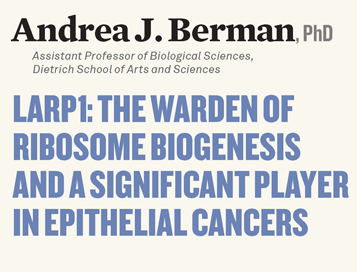
Topic Overview:
An intricate choreography of RNA binding proteins regulates cellular function and homeostasis. These proteins perform numerous and varied roles in messenger RNA (mRNA) transcription, turnover, subcellular localization, and translation. The Berman Lab integrates molecular, biochemical, and structural techniques to understand how the formation and remodeling of specific ribonucleoprotein complexes affect these central molecular processes—and how their dysfunction leads to oncogenesis.
One such RNA binding protein, La-related protein 1 (LARP1), has been linked to several epithelial cancers, including that of the ovary, cervix, colon, and liver. LARP1 interacts with the untranslated regions (UTRs) of mRNAs to direct them into pathways for translational repression or activation. LARP1 contains three RNA binding domains, the La- and RNA recognition motifs, which are predicted to form a structural module, and a highly conserved C-terminal region, named the DM15 motif. Only recently was LARP1 discovered as the critical node in signaling by the growth-responsive mTOR kinase for regulating ribosome biogenesis. Berman and colleagues previously demonstrated that LARP1 directly associates with the 5’ UTRs of mRNAs encoding ribosomal proteins and translation-associated factors. LARP1 also interacts with poly-A binding protein (PABP), a component essential for mRNA stability and efficient translation.
Berman and colleagues used X-ray crystallography and biochemistry to determine the molecular basis for the interactions between the DM15 motif of human LARP1 and RNA. Their data reveal that LARP1 uses an unanticipated mechanism to silence ribosome biogenesis and stabilize these messages. This interaction is unique to LARP1 among all intermolecular interactions in the cell and, therefore, represents a rare opportunity for destabilizing the messages required for all cell growth and proliferation.













